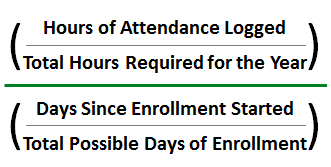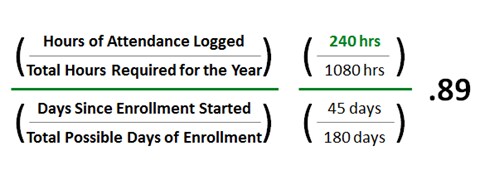How to Establish a Morning Routine for Kids
by Emily Ewen
byConnections Academy
5 min to readIn traditional brick-and-mortar schools, attendance is usually tracked when a student says “here” after hearing their name during roll call. If the teacher can validate the student’s physical presence, attendance credit is most likely received without additional obligation.
So how is attendance monitored in an online or blended school when a student is not physically present? Simply “showing up” for a virtual course is not enough to earn attendance. Rather, attendance in online and blended schools is determined by various factors that reflect your student’s overall progress and academic development. Read on to learn more about how virtual schools like Connections Academy® track online school attendance and blended school attendance, while also providing scheduling flexibility.
How is attendance tracked in virtual school? At Connections Academy, we use a proven set of actions to make sure students are physically present and making positive progress. Here are four touchpoints for creating a similar online attendance system for school:
Despite the fact that teachers are not able to see your student sitting in a physical classroom, they still need to verify that they are present within the virtual classroom. Physical existence is measured by logged contacts with the school. For instance, each time the student communicates with the school, the conversation is documented and logged into the system. The school also looks at the time between the present day and the most recent synchronous contact, such as a phone call, that they’ve had with the student. This is one of the only methods of attendance monitoring that can be initiated at the school. It is also an especially effective attendance policy for online students in high school, since students at this age tend to experience even more autonomy over their schedules.
Another vital component of a good online attendance system for school is creating a way to track recent activity. To track recent activity, teachers look at the student’s last completed lesson and assessment, and the time between the present day and the most recent tracked action. The last login date is not included in the teacher’s track record because the learning management system allows Learning Coaches to access course content on behalf of their student. Thus, merely logging in does not accurately reflect a student’s attendance.
One of the most important factors in tracking online school attendance is the daily learning hours logged by a student’s Learning Coach . If a Learning Coach is not reporting enough hours to satisfy the state’s requirement, the student’s attendance record could suffer significantly. Since the hours cannot be changed once they are entered, the Learning Coach should make sure to tally them up correctly. Teachers have the option to edit the hours if they believe that the student has not sufficiently participated. These self-reported and school-verified hours of attendance are key aspects in determining attendance and absences.
Maintaining a suitable learning pace is another necessary requirement of accurate attendance for online school. The learning pace should be regulated by the student and their Learning Coach. Although taking online courses allows students to work at their own pace, the school still expects all assignments and lessons to be completed by the end of the school year. In order for students to finish on time without rushing, they should work at an appropriate pace on a daily basis.
To accurately determine your student’s pace, use the equation provided below:

For example, in Arizona, high school students need 1,080 hours of attendance, or a recommended 6 hours per day. If a student logged 270 attendance hours during the first 45 days of the school year, the result would be the ideal percentage value of 1; if a student took one week off and logged 240 attendance hours, the result would be a pretty manageable percentage value of .89. A student with fewer than 200 logged hours in this case could fall behind and might have to resort to cramming in order to meet the attendance requirements.


Since blended high school students usually spend part of the week on campuses, receiving face-to-face lessons from teachers in addition to online courses, attendance should be monitored differently than in full-time online school. Here are two crucial elements to setting up an effective system for tracking blended school attendance:
Physical presence is tracked heavily to ensure that the student is successful and ready to advance to the next grade level when the time comes. As is the case for a Learning Coach, a Success Coach is responsible for logging their student’s daily learning hours, including time spent on-site and off-site. Success Coaches are also responsible for checking in with their students on a weekly basis, which is incorporated in the hourly log as well.
During the first 40-minute block of each in-person session, students convene for an advisory period where a Success Coach leads a learning activity to foster collaboration and teamwork. This advisory period accounts for 5% of the student’s English participation grade.
Even though online and blended school students are not always physically present, remaining proactive in daily learning responsibilities is an essential part of student accountability and academic growth. These online school attendance strategies will ensure your student stays on pace for a successful year end.
